More Hunting On The "Upsidedown" Line
by The Beach Boys
Reprinted from "Crown Jewels of the Wire", January 1987, page 28
Yes, the Beach Boys have returned! For those of you who enjoyed the EC&M
article in the January, 1986 issue of CROWN JEWELS, we now have another
adventure to tell you about. There is a new member in the band this year. I
wasn't really sure what to nickname him. At first, I thought about "Dinty
Moore," due to his love of the famous Dinty Moore beef stew. But as time
went on, something more appropriate would surely come to mind.
At any rate, we met at our destination at 9:20 on a Saturday night. Both of
us had a lot of stories to tell of the experiences on our trips there. We must
have been up 'till one in the morning or so yakking about what took place
"on the way in" and about the events that might take place in the few
days ahead of us. After pulling two upside down embossed EC&M's off a line
last year, it made one wonder if we could find anything this year that could
compare in rarity or value. But, hey, we were here to have fun.
Sunday found us getting our digging tools, food and other gear ready for the
big dig. It was into the afternoon before we finally got started working the
line. I located a couple of tie wires and paced off the next pole for ole "Dinty."
After returning to my pole site I heard him yelling to me. He had located some
tie wires, nails, and what appeared to be a deteriorated threadless side
bracket. Needless to say he was all wound up, since up to this point he hadn't
even found a piece of a threadless on his digs in other areas on later lines. So
it was all pretty exciting for him. He decided he wanted to dig this spot all by
himself, so I continued digging at my pole.
Getting my rake back into the ground
was a pleasurable experience. The moss and pine needles were damp and the smell
of pine trees and all the other scents of the wilderness gave me a good feeling
inside. Nearly a year had passed since my rake saw any work on this old line
which has been good to me in the past. I've been working it for six years now,
and believe me, there are a lot of good experiences that have taken place
because of the "digs." The rust had no sooner given way to a shinier
surface on the teeth of my rake, when up came the first piece of glass. One
could hope for a threadless or even one of those upside down critters. But the
variety on this line can make anything possible. There seems to be such a
variety due to the first threadless going back to 1865 and then as the years
went by, Chesters, Mulford & Biddles, and McMickings being put into service.
Then, in the 1870's and 80's both Cal. Electrics and EC&M's being used as
replacements. There are also rebuilt sections that used a lot of one or more of
the later items. So you can find a Tillotson from the '65 shipment or a Cal.
Electric from the 80's.
So now, getting back to my first piece of glass on our
hunt this time around, it was something different than any of the items
described above. It seems as though a batch of CD 133 dome dated Brookfield
signals were also sent here, as there before me was a nice shiny aqua one. It
had met the elements there in the ground, for the frost had popped off the top
section of the dome. I grabbed my gear and headed on up the line, giving some
encouraging words to "Dinty" as I paced the next span from him.

The threadless side bracket (in dark circle) can be seen as it was
first spotted on the tree. |

Klingensmith on the rise...climbing up for a closer look. |
Upon
getting to the next digging area, I spotted a real beauty in the tree above me.
I had found a real rarity. This time it wasn't a piece of glass that caught my
eye, but rather an old wood threadless side bracket that looked like it was put
up five years ago! It was in super condition. Within a few seconds there was
another pair of eyes looking up at it too! Fortunately there was another smaller
pine tree growing close to the old timer that held my bracket. So I was able to
climb the smaller one and reach over to inspect my find. A closer view revealed
small patches of moss growing on the bracket which gave it real character. We
decided to wait until the next day to remove it as the light conditions were
deteriorating as far as getting some good photos were concerned. So both of us
went back to digging, myself in hopes of finding the insulator that was placed
on the bracket over one hundred years ago. Darkness began to set in before I
could rake over much of the area. We turned in by nine that night.
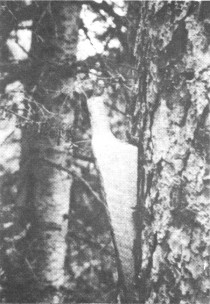
The bracket, in remarkable condition for an item over 100 years old,
clings to the tree. |
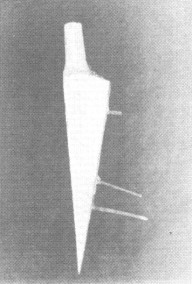
Three long cut nails anchored this rare find and made for its
difficult removal. |
We woke at 7:37 (Lefferts time) on Monday morning. The conversation
immediately took the form of our telling each other of our dreams that night. I
was humored to hear about how we had been attacked by MIGS during the night. It
reminded me of a book I read in my research on this time entitled "Tent
Life in Siberia." Enough about our dreams, it was time to get to work! I
finished digging around the tree where the bracket was found and failed to find
any glass. After taking some pictures I proceeded to try to remove the bracket.
Fortunately the bracket was not embedded in the tree. The tree had pushed the
bracket outward, rather than growing around it as is sometimes the case.
However, the old, square cut nails were really embedded and it took at least
fifteen minutes to carefully work it free. I was more pleased with a historical
find like this than if I had found a threadless insulator.
From there we continued to work the area, and finally at three in the
afternoon my digging partner pulled up his first whole insulator of the trip. Of
all things, another CD 133 Brookfield. So now he had another nickname -
"Brookfield Bernie." That evening I came up with my second insulator
of the hunt, none other than another Brookfield.
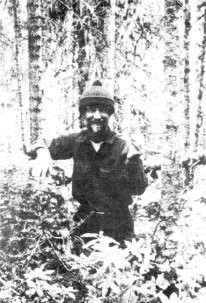
"Brookfield Bernie" with one of several CD 133
Brookfield signals found. |
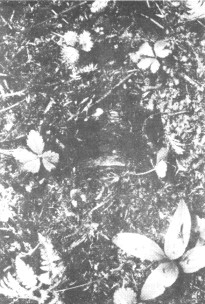
The bottom edge of Bernie’s Mulford &
Biddle can be seen protruding from beneath the moss and pine needles. |
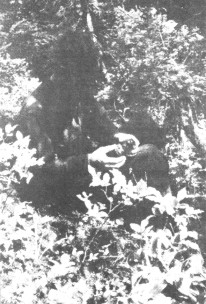
Bernie takes a closer look at his prize Mulford & Biddle. |
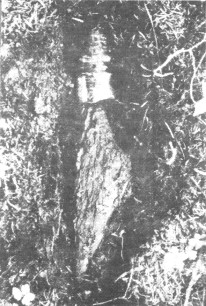
A Brookfield mounted on a "long necked" bracket, most likely
supplied by EC&M CO, is shown after the pine needles have been pulled away. |
The next morning we were up and at it by 7:35 (Chester time). We put in a
pretty hard day, and by that evening some of the excitement, and at least a
little of the energy had worn off. But old "Brookfield Bernie" came
through with better than half of a threadless CD 735 Mulford & Biddle. He
was pretty excited with it, and it gave us hopes of finding more the next day.
Wednesday morning dawned, and rather than discussing our dreams of the night
before, Bernie gave me a real serious look as he attempted to convince me that
what he was about to say involved something that had really happened the night
before and was not a dream. He told me he had heard two mosquitoes talking
outside during the night and their topic of conversation was none other than the
two of us! The conversation according to Bernie was as follows:
Mosquito #1 - "Hey, do you see those two humans laying there?"
Mosquito #2 - "Yeah, do you think we should eat them here, or take them
home and have them for lunch?"
Mosquito #1 - "I think we better eat
them here. If we carry them home, the big ones will probably take them away from
us."
Bernie's story gave me something to look forward to as I crawled outside for
a look. If you've never been attacked by the huge swarms of mosquitoes that can
come with these digs, you're missing a real treat! We finally got going that
morning, and a couple hours later I was running my detector near a tree when it
signaled some metal. I dug down to find an ancient coin. I ran on up to where
"ole Brookfield" was working and showed off my find. After getting
back to the tree, I decided to make sure there weren't more coins. However, the
detector indicated there was still more metal buried there. Up came another coin
and then another, and then another, and then....by the time Bernie got there, I
had 6 coins, the oldest dating back to the 1850's.
An hour later Bernie did some
yelling of his own. When I asked him if I should bring the camera with me to see
his find, his reply was that it would save me a trip back to get it by bringing
it now, so I knew he had something good. When I got up to where he had been
digging, I realized he had uncovered his first whole threadless -- a CD 735
Mulford & Biddle. It was a real nice one, a small frost crack in it, but no
glass missing. Needless to say, Bernie was all smiles. He had progressed from
"Brookfield Bernie" to the distinction of being called "Bernie
Biddle" from here on. By the way, the Mulford & Biddle was lying in a
position where the dome was lower than the skirt, so I told Bernie it was
"almost an upside-down one."
We decided to take a day off Thursday and did a little sightseeing. It's hard
to take a break after you make a good find, but we needed a rest anyway. Besides
we are on vacation and need to relax and enjoy ourselves.
Friday found us back on the line. My first find of the day came on its
original threaded bracket. The bracket was the right type. It had a nice long
neck on it, probably an EC&M product. It was in pretty fair condition for
having been in the ground for several decades. The insulator, unfortunately, was
not from San Francisco, but rather a New Yorker -- another Brookfield signal.
Bernie then found his first jewel of the day, of all things, another Brookfield!
From there we did more pacing to locate the next couple of poles. I located a
tie wire and did a little digging. I paced the next pole for Bernie, after which
time he found a couple tie wires. I proceeded at that time to tell him I had
managed to develop a bad attitude and things weren't looking too good. Normally,
I hang right in there and really go at it, but it was hard work and all there
seemed to be was a bunch of Brookfields.
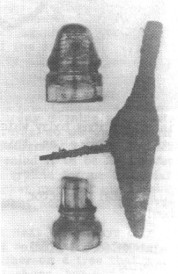
The Brookfield and bracket it was mounted on are shown here with half
of a CD 735 Tillotson, which made its arrival in 1865. |
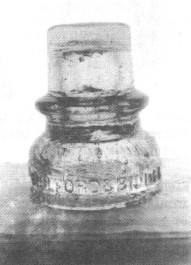
The "upside down" Mulford & Biddle which is in almost
perfect condition. |
Only half interested in digging I went
back to work digging where I had found the tie wire. After about a half hour, I
was digging right up to a tree that must have been a couple hundred years old.
Much to my amazement there was a upside down insulator setting right against the
base of the tree. Now what kind of upside down insulator do you think I'm
talking about? You know about the EC&Ms, but then it could also be a
Brookfield standing on its head, right?
Things were looking good that day because what was standing perfectly upside
down was a Mulford & Biddle with a real nice bubbly-milky swirl in it. I
couldn't believe it had laid there for umpteen years with its base in the air
and yet it hadn't filled with water and frozen. Apparently resting against the
tree had prevented any water from getting inside. And to top off a great find,
in looking up the side of that tall tree I noticed a dark spot over twenty feet
up. Could it be a bracket? It's hard to climb a tree with no lower limbs, so
fortunately once again a small tree growing next to it allowed for a closer
inspection.
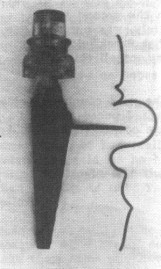
There aren't many threadless in collections today which are accompanied
by their original bracket and tie wire as this one pictured. |
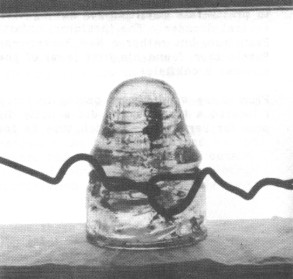
It's "easy find in'" when your metal detector locates
insulators with tie wires still attached! |
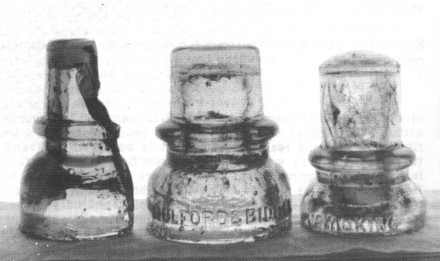
A broken Tillotson, almost mint Mulford & Biddle and a McMicking.
Not bad for three days of digging. |
Sure enough, I had in fact located another threadless bracket. Once again the
condition of the wood was incredible. This one had the old "gable"
type cutout on the backside. An animal, most likely a squirrel, had gnawed away
the upper portion of the round, pin part of the bracket after the insulator had
been removed, but it was still a great find.
Saturday morning gave better lighting conditions for taking pictures, so we
waited until then to remove the bracket. A measurement of the distance from the
ground before it was removed revealed it to be 22-1/2 feet up. That's a little
too far off the ground for me when dangling from small branches, but the bracket
came off pretty easy this time. The remainder of the day brought none other than
two more Brookfields for Bernie.
The next three days didn't reveal very much. Bernie managed to find a
partially decomposed threadless bracket, and I found another on a tree that was
lying on the ground. It was in fairly nice shape, but not as nice as the other
two I had found. The weather really wasn't holding out too well for us by this
point, so we finished off this stretch of the line just in time.
The last day of digging, Bernie mentioned he would only get wet one more time
here and that was on the way to the truck. His famous last words were "I'm
sure glad I brought my raincoat. It saved me from getting pneumonia. What
happened to the nice days when we first came here?" It made me stop and
think of the grinding torture I put the rest of the Beach Boys through on these
famous digs. But Bernie put up with the elements quite well. The only complaint
I had of him was that he refused to go to the beach with me so we could get our
picture taken together!
Our big dig was pretty successful in my opinion. Our total haul was several
CD 133 Brookfields, two good Mulford & Biddles, four threadless brackets, a
McMicking and a couple of broken threadless. The abundance of the Brookfields
really amazed me. When one considers the rebuilds that took place on this line
over the years and, more importantly, the relocation of the line in places
sometimes as many as three times, it begins to explain a few things. Another
surprise was that we only found one of the "old timers," an aqua CD
735 Tillotson that was about one half complete. Once again, the line relocation
factor involved here probably eliminated some of the early items. This is
unfortunate in some respects, since in the past I have located a couple of
really nice Tillotsons in both directions from where we were now digging. But,
we must be happy with what we find as far as the threadless go. I've also found
some McMickings on this stretch of line.
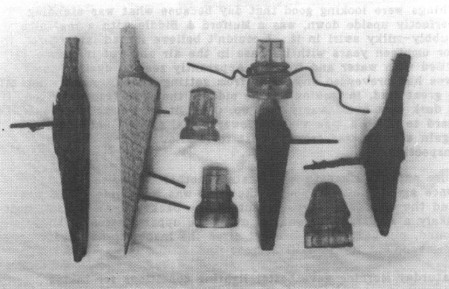
Part of the "finds." Threadless bracket found on a fallen
tree, the first threadless bracket found, a McMicking, broken Tillotson, Mulford
& Biddle on original "gable type" threadless bracket, Brookfield
signal and the bracket it was found on -- probably the bracket was supplied by
EC&M CO. |
In fact, I was so excited about the Biddles and brackets found on this trip,
that I forgot to mention the broken and whole McMicking I found on this dig.
After all, it was those McMickings that got me started here years ago, so we
can't forget them! As for the upside down EC&M that may still be out there,
I haven't totally given up on the possibility of another one eventually turning
up. After all, there are still 400 plus miles of line to cover, but,
unfortunately, the elusive upside down section has now been pretty well raked
over. Who knows, maybe next January there might just be another article by the
Beach Boys. We'll have to see what next summer holds. Perhaps there are more
California Girls out there! And we can't forget the New York Girls on (16)
Broadway either!
|
